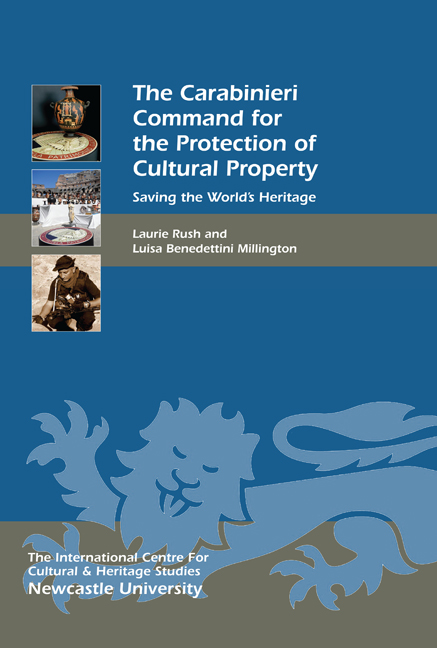Book contents
- Frontmatter
- Contents
- List of Illustrations
- Acknowledgments
- Foreword (in English and in Italian): Brigadier General Mariano Mossa
- Prefazione
- Abbreviations
- 1 The Carabinieri TPC: an Introduction and Brief History. Perché l’Italia? Why Italy?
- 2 Headquarters, the Databank and Operative Department in Rome
- 3 Carabinieri Public Outreach and Education
- 4 Central Italy and the Adriatic: Lazio, Florence, Bologna and Ancona
- 5 Activities in the North: Genova, Monza, Torino and Venezia
- 6 The Regional Offices: Naples, Bari and the South
- 7 The Challenges of the Island Regions: Sicily, Sardinia and the Palermo, Siracusa and Sassari Nuclei
- 8 Investigation Techniques
- 9 Repatriation of Works of Art to Italy: From Siviero to the Medici Conspiracy
- 10 Fakes, Forgeries and Money Laundering
- 11 Who Are the Officers of the Carabinieri TPC?
- 12 The Carabinieri, Peacekeeping and Foreign Relations: The Carabinieri Mission to Iraq
- 13 ‘The Italian Model’
- Bibliography and References
- About the Authors
- Index
- Heritage Matters
1 - The Carabinieri TPC: an Introduction and Brief History. Perché l’Italia? Why Italy?
Published online by Cambridge University Press: 21 May 2021
- Frontmatter
- Contents
- List of Illustrations
- Acknowledgments
- Foreword (in English and in Italian): Brigadier General Mariano Mossa
- Prefazione
- Abbreviations
- 1 The Carabinieri TPC: an Introduction and Brief History. Perché l’Italia? Why Italy?
- 2 Headquarters, the Databank and Operative Department in Rome
- 3 Carabinieri Public Outreach and Education
- 4 Central Italy and the Adriatic: Lazio, Florence, Bologna and Ancona
- 5 Activities in the North: Genova, Monza, Torino and Venezia
- 6 The Regional Offices: Naples, Bari and the South
- 7 The Challenges of the Island Regions: Sicily, Sardinia and the Palermo, Siracusa and Sassari Nuclei
- 8 Investigation Techniques
- 9 Repatriation of Works of Art to Italy: From Siviero to the Medici Conspiracy
- 10 Fakes, Forgeries and Money Laundering
- 11 Who Are the Officers of the Carabinieri TPC?
- 12 The Carabinieri, Peacekeeping and Foreign Relations: The Carabinieri Mission to Iraq
- 13 ‘The Italian Model’
- Bibliography and References
- About the Authors
- Index
- Heritage Matters
Summary
The Carabinieri Command for the Protection of Cultural Property – in Italian the Comando Carabinieri per la Tutela del Patrimonio Culturale(TPC) – is the most effective military policing force in the world for protecting works of art and archaeological property. There are outstanding officers and programmes elsewhere, but there is no other force that can match the operational organisation, range of expertise, capabilities, nor the record of Carabinieri TPC accomplishment. Given the fact that Italy may be viewed as an open-air museum with perhaps the highest concentration of art and archaeological treasure per square kilometre in the world (CC TPC 2008), it is not surprising that the Italian people would make protection of art and archaeology a national priority. In addition, appreciation of art and beauty is an essential element of Italian culture.
PROTECTION OF HERITAGE, HISTORICAL CONTEXT FOR AN ITALIAN ETHIC
Protection of elements in the Italian landscape dates back at least 2000 years. One of the earliest examples of stewardship in Italian culture was the protection of the sacred forest of Monteluco. The forest is marked by a 3rd-century BC Roman inscription called the Lex Spoletina, which clearly indicates that the forest is protected. Any individual caught illegally harvesting wood from within this sacred forest was required to sacrifice an ox to Jupiter. Only 200 years after the Romans carved and placed the warning of the Lex Spoletina in the forest, Cicero set a legal precedent with the prosecution of Verres, a Roman Senator and Governor of Sicily. The people of Sicily brought suit in the Roman judicial system against Verres, who they accused of illegally appropriating works of art for his personal use. The famous Roman lawyer and orator Cicero agreed with the Sicilians and took the case. Cicero's prosecution of Verres is still referred to as setting the standard for the behaviour of conquering powers where art is concerned, even at a time when warring armies plundered cultural property as part of the spoils of victory. Cicero's prosecution also set guidelines for public versus private appreciation of art.
More recently, in 1646, the Vatican State issued the first relatively modern set of laws governing the protection of cultural property in Italy. At that time, the region we now recognise as the modern State of Italy was governed by a series of independent states and the Vatican owned a large area of central Italy.
- Type
- Chapter
- Information
- The Carabinieri Command for the Protection of Cultural PropertySaving the World's Heritage, pp. 1 - 14Publisher: Boydell & BrewerPrint publication year: 2015



